Last update: 5 June 2013
Contents:
1. Introduction
2. Robot Machine Configuration
3. iOS Device Configuration
4. Automation
APPENDIX:
A. T-Plan Server Re-signing Process
1. Introduction
T-Plan Robot Enterprise version 3.3 introduced a new hybrid connection called "iOS Mirror". It allows to test
Apple iOS devices over a T-Plan Server or VNC
connection where the device screen is displayed on the local desktop
using the AirPlay Mirroring technology. This connection allows to
test iOS applications which don't work over the classic VNC Server
connection well, for example games relying on the OpenGL technology.
It is recommended to use the T-Plan Server instead of VNC due to a
number of advantages.
|
iOS Mirror
connection w/
T-Plan Server
|
iOS Mirror connection w/
VNC server (Veency)
|
VNC Server connection w/n
VNC server (Veency) |
Supported since
|
Robot v3.5
|
Robot v3.3
|
Robot v2.0
|
Jailbroken device
required
|
NO
|
YES
|
YES
|
Support of apps with
OpenGL content
|
YES
|
NO
|
NO
|
Pinch/Zoom support
|
YES
|
NO
|
NO
|
UTF-8 character
support
|
YES
|
NO*
|
NO*
|
Display orientation
support
|
YES
|
LIMITED**
|
NO
|
Connections per
machine
|
1***
|
1***
|
NO LIMIT***
|
* The RFB (VNC) protocol is limited to ISO 8859-1
characters.
** Only the portrait & counterclockwise landscape modes are
supported.
*** One machine running Robot can automate only one iOS device
over the iOS Mirror connection at a time because it relies on an
exclusive access to the local desktop. The standard VNC Server
connection doesn't apply any limit to the number of connections
and one Robot machine may automate any number of iOS devices at a
time up to the limit given by the license key as long as there are
sufficient system resources (CPU, RAM).
Device Requirements:
- An Apple iOS device capable of screen mirroring. See
the online iOS
Compatibility Status page for the latest information. A
connection to the network is also required (usually over WiFi).
- For the T-Plan Server driven testing, the device must
have iOS 5.0 or higher and the server application must be
installed and running on the device.
- For the VNC driven testing, the device must be
jailbroken and Veency
must be installed and running on it. See the online iOS
Compatibility Status page for the latest jailbreaking
status.
Robot Machine Requirements:
- Operating system:
- Any MS Windows supporting window translucency (in
general, Windows Vista and later).
- Mac OS X 10.7 (Mountain Lion) or higher (supported
since Robot v3.4.1).
- AirServer or Reflector installed and
activated ("the mirror app"):
- AirServer is recommended for Windows because it
is cheaper than Reflector and it seems to be more stable and
faster.
- Reflector is the only option for Mac OS X. Though
Robot will also recognize AirServer it is not suitable for
automation for practical reasons. It starts by default in the
full screen mode which is not supported by Robot. It also uses
pop up tool and title bars which interfere in the screen.
- Java 1.7 or higher. The connection will be disabled
when Robot runs on Java 1.6. It is highly recommended to use Java
from Oracle which is also the only option for Mac OS X.
- It is recommended to use a display with a resolution
sufficient to fit the device screen both in portrait and
landscape modes (iPhone 4S screen size: 640x960, iPad 2:
1024x768). Environments which do not comply with this
requirement may take advantage of the mirror app scaling (right
click Reflector -> Scale
-> "Half Size" or "Actual Size").
2. Robot Machine Configuration
MS Windows Set Up
Mac OS X Configuration
- Install Java
JDK
1.7 from Oracle.
- Enable accessibility:
- Click the Apple menu and select System
Preferences. Alternatively click the System
Preferences icon in the dock.
- Double click the blue Accessibility icon
under the System group.
- Set on the Enable access for assistive devices
check box at the bottom of the window.

- Install Robot v3.5 or later. Make sure to choose the
distribution packaged as Mac OS X application for Oracle
Java 1.7. Alternatively use the standalone cross platform
release.
- Install Reflector
and activate it. Though Robot will also recognize AirServer it
is not suitable for automation on Mac. It starts by default in
the full screen mode which is not supported by Robot. It also
uses pop up components which interfere in the screen.
AirServer / Reflector Set Up
While the mirror app is disconnected right click its
icon in the system tray (Windows) or go to the Device menu
(Mac OS). Select Preferences/Settings. Set the options as
follows:
- Full screen - OFF (Reflector only)
- Always on top - ON (recommended)
Connect the Apple device to the mirror app:
- Connect the device to the same network the Robot machine is
connected to (usually over the WiFi).
- Follow the AirServer
/ Reflector
instructions.
Post connection configuration:
- Reflector only: right click the app (Windows) or select the Device
menu (Mac OS). Set off the Show Frame
option to make it display just a plain screen without the
white/black iPhone hard cover image.
- Choose the mirror size (Scale/aspect) carefully and keep it
constant. It is recommended to set the mirror size equal to the
actual device screen one as long as it fits your screen. This
keeps the image blurring caused by the lossy H.264 compression
at a minimum.
Robot Set Up
- Start Robot and verify the following:
- Robot must be running on the default Graphite Look
And Feel (LAF) scheme. The standard Oracle delivered LAFs such
as Metal,
Nimbus,
CDE,
GTK+
or Windows/Windows
Classic will not work. Other ones supported by Robot
may or may not work. To verify or change the LAF either click
the More... link in
the Login
Dialog or navigate to Edit->Preferences and
select the Appearance & Accessibility
node.
- Open the Help->About dialog and verify
that Robot runs on Java 1.7.
3. iOS Device Configuration
Device Configuration
It is recommended to set off the Auto Lock feature
to prevent the device from going to sleep after the specified idle
time:
- Tap the Settings icon in the iOS home screen.
- Go to General -> Auto Lock and
select Never.
VNC Set Up
- Install Veency from Cydia.
- Refer to the Release
Notes document for Veency set up instructions.
T-Plan Server Set Up
The T-Plan Server is being distributed as an "Ad Hoc" iOS
application (.ipa) signed by the T-Plan certificate. To use the
server within your organization you will have to re-sign it with
your own company certificate and create a provisioning profile
with the list of devices allowed to run the server. This is a one
time process and the re-signed application and the profile may be
then freely distributed to your testers.
The T-Plan Server application and the provisioning profile can be
installed onto the device from a Mac OS X 10.7+ or a MS Windows
machine. An alternative installation of the profile is to mail it to
the device as an email attachment and tap it in the mail client.
Installation from Mac OS X
- Connect the device over the USB cable to the Mac.
- Drag the profile (.mobileprovision) and the T-Plan Server app
(.ipa) to the iTunes icon in the dock.
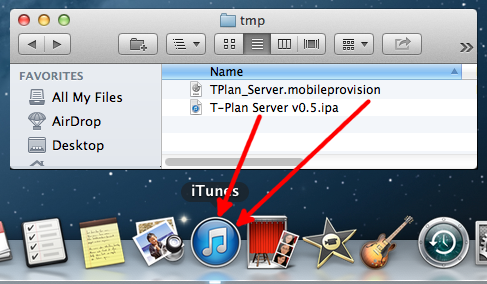
- Open iTunes.
- Select the device under the DEVICES section in
the left tree view and click the Sync button at
the bottom right corner. This will install the profile on the
device. To verify it tap the Settings icon in the
iOS home screen and navigate to General->Profiles.
- To install the server from iTunes:
- Reselect the device under the DEVICES section
in the left tree view.
- Switch to the Apps tab.
- Click the Install button next to the T-Plan
Server application. The label will change to "Will
Install".
- Select Apply to install and start the server
on the device.
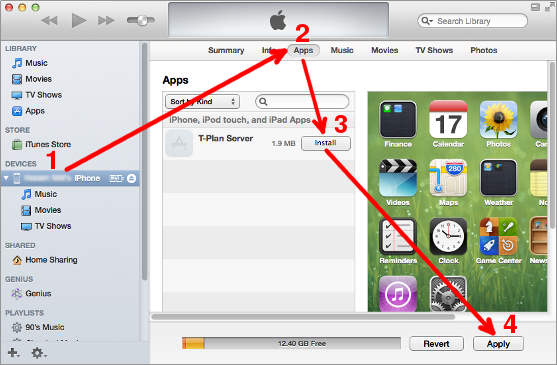
Installation From MS Windows
The server and the profile may be installed using iTunes for Windows.
The process is same as the Mac OS one above. The only difference is
that you have to drag the files to the Apps folder
under the LIBRARY section of the left menu.
Another option is the iPhone Configuration Utility:
- Select the device under the DEVICES
section.
- Click Add on the tool bar. Select the "Mobile
Provision (.mobileprovision)" item in the "Files
of type" drop down at the bottom of the file
selector. Then select the downloaded provisioning profile.
- Switch to the Provisioning Profiles tab.
- Click the Install button next to the profile.
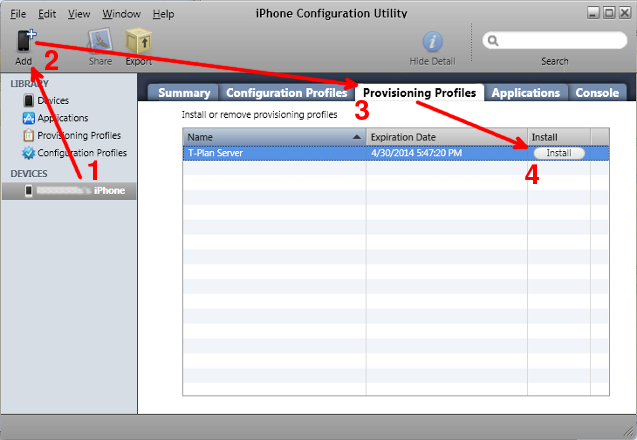
- Install the server app (.ipa) in the similar manner:
- Click Add again. Select the "Mobile
Application (.ipa)" item in the "Files of
type" drop down. Then select the server .ipa file.
- Switch to the Applications tab.
- Click the Install button next to the server
application.
- Tap the T-Plan Server application on the device to start it.
3. Automation
Connection from Robot
- The device must be connected to the network over the WiFi.
Check if the T-Plan Server is running on the device and
start it eventually. When it asks you for access to the current
location approve it. If you accidentally select "Don't
Allow" please enable it under iOS Settings
->Privacy->Location Services.
- Start Robot, select the "iOS
Mirror"connection type, provide the device IP address
and the port and hit Connect. For the T-Plan Server
connection use the IP address and the port of 5909 displayed in
the server window. For the VNC Server connection use the device
IP address with the port of 5901. If neither AirServer nor
Reflector is currently showing the device screen, Robot will
wait for it. On a successful connection Robot will display the
mirrored screen in the desktop viewer.

- To connect to a device from a test script use the Connect command (TPR scripts)
or the connect()
method (Java test scripts). The argument URL must be in form of
"apple://<address>:<port>".
For example, the following lines will connect you to an Apple
device with the IP of 192.168.100.1 running the T-Plan Server:
TPR test scripts:
Connect apple://192.168.100.1:5909
Java test
scripts: connect("apple://192.168.100.1:5909");
Troubleshooting
- Robot maintains itself as the topmost window with the mirror application
positioned behind its desktop
viewer. If the mirror application is not configured to
stay always on top, Robot may fail to bring it into the desktop
view after the connection. To overcome this click the mirror app
icon in the Windows task bar to push it to the front and then
click the Robot's title bar to lock the application in the
viewer.
- Robot identifies the mirror application in the local OS by the
window title. When the
mirror app is visible but Robot fails to establish the
connection saying "Waiting for AirServer/Reflector to start" go
to Edit->Preferences
in the main UI and select the "iOS Mirror" panel. There's a list
of semicolon separated
java.util.regex.Pattern regular
expressions used to identify the mirror application title.
Update it to match the mirror app window title. On Windows hover
the mouse over the app in the Windows task bar to get the actual
title. An alternative approach for both OSes is to enable the
debug mode in the iOS Mirror panel, make an
attempt to connect and check the log (Help->Log Viewer)
for the list of displayed windows and their titles.
- If Robot fails to display just the device screen and you can
see the application title bar and/or the surrounding frame or
other components in the desktop viewer, go to the "iOS Mirror"
panel and look for the inset preferences. They will allow you to
adjust the view manually.
- Robot is not responsible for the AirServer or Reflector
failures. Should you have any problems with these applications
please contact their support desks.
Automation Tips
- The T-Plan Server is marked as a Navigation and VoIP
application in order to be allowed to run in the background. To
avoid draining of the device battery we recommend to keep the
device connected to the power during automation. When the device
is not being automated the server may be killed as follows:
- Double press the Home button on the iOS
device to open the list of running applications.
- Scroll to the right (swipe to the left) if needed to locate
the T-Plan Server application.
- Long press the application icon until it starts shaking.
Then press the "red minus" icon to kill it. Finally press Home
to go back.
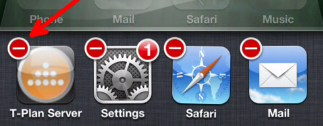
- Avoid running other applications which use the Always
On Top window mode during automation. They can pop
up unexpectedly and interfere with the Robot desktop view.
- Should you need to control the mirror app directly while it is
locked in the Robot view on Windows, minimize the Robot
application to the task bar. Robot will re-lock it after its
window gets restored.
- Keep the size of the mirrored screen constant. As template
images created against one particular screen size will not work
on another one, any later change will require you to recreate
all template images or create alternative ones for the new
resolution using the Image
Collections.
- As the iOS device screen is mirrored using H.264 video with a
lossy image compression format,
the artifacts (components) on the screen change at the pixel
level. To search for them using Robot template images use the search2 comparison
method with the pass rate of 50% or lower.
- The landscape mode is supported only when the device is
rotated counterclockwise
(the Home
button on the iPhone is on the right). If the device is rotated
clockwise no error will be reported but the mouse clicks and
drags will not be placed correctly.
- Unlike in some VNC connections, the mouse pointer is not drawn
into the local screen image which Robot works with. You don't
have to make your scripts move the mouse pointer away to perform
image comparison over a certain area.
- As automation is performed on the local desktop, one machine
running Robot can be used to automate only one Apple device at a
time.
APPENDIX A
T-Plan Server Re-signing Process
Requirements:
- Mac OS X 10.7 (Mountain Lion) or later.
- An Apple Developer Account.
- Xcode installed (v4.x or higher recommended) with the Command
Line Tools package. To install the tools:
- Start Xcode and select Xcode->Preferences
in the menu.
- Switch to the Downloads tab.
- Select Install next to the Command
Line Tools package.
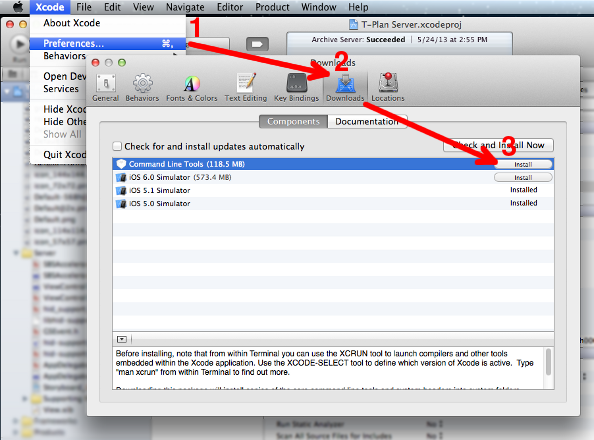
Re-signing Process
Step 1: Register
the test devices
NOTE: This step is
required only if the test iOS device(s) haven't been registered
yet.
- Sign in to the Apple
Developer Center using your Apple ID.
- Select the Devices link under the Member
Center->Certificates, Identifiers & Profiles section
of the Apple Developer Center.
- Register the device(s) that you plan to run
the T-Plan Server on. You will need the device UDID (Unique
Device Identification Number). One of the many ways to get
it is to connect the device over the USB cable to the Mac and
use iTunes:
- Start iTunes and select the device under the
DEVICES section in the left tree view.
- Switch to the Summary tab.
- Click the Serial Number field. It will change
to Identifier (UDID) and display the UDID.
- Right click the number and select Copy Identifier
(UDID).
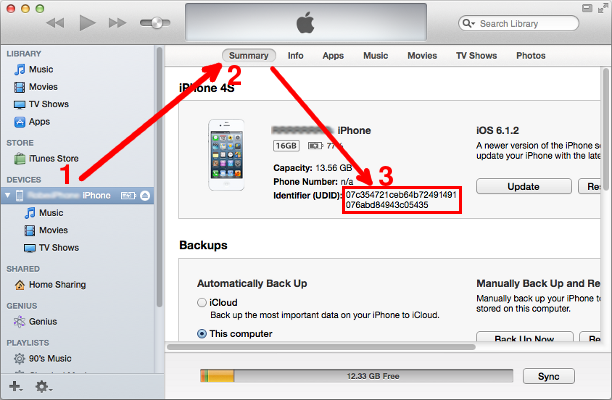
- Alternative way to get the number is to install an iOS
application providing the UDID, such as Emonster's
UDID+.
- Once you have the UDID click the "+" button
under the Devices section of the portal and
complete the device registration.
Step 2: Create the
provisioning profile
- Switch to the Provisioning Profiles section.
- Click the "+" button to create a new profile:
- Select the "Ad Hoc" profile type.
- Select the iOS Wildcard Aple ID.
- Select the appropriate distribution certificate.
- Select the devices you wish to allow to run the server on.
You must add at least one device.
- Provide the profile name, for example "T-Plan Server"
and select Generate.
- Select Download to download the
"T-Plan
Server.mobileprovision" file to your
local file system.
Step 3:
Get the certificate
- Go to Member Center->Certificates, Identifiers &
Profiles and select the Certificates
link in the iOS Apps group.
- Download the iOS (iPhone) distribution certificate.
- Open the certificate from Downloads or Finder.
This will import it into your key chain. Then look at the
certificate under the My Certificates screen of
the Keychain Access window and jot down the name.
It should look like "iPhone Distribution: <name>".
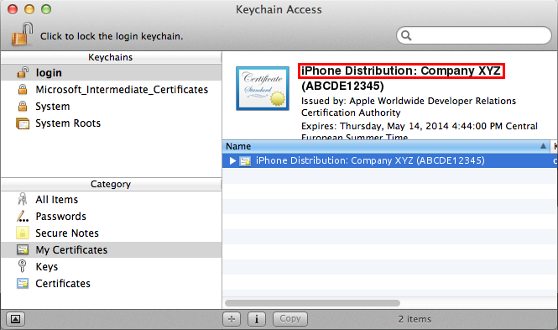
Step 4: Resign
the application
NOTE: This step can be alternatively performed using other
applications/scripts allowing to resign an .ipa file, such as iResign, AppResigner
or the ota-tools.
Another option is to call the codesign utility
manually from the command line (see here).
The script we provide is usually the fastest option.
- Create an empty folder and copy the provisioning profile into
it.
- Download the T-Plan server ZIP file and extract it to the
folder. The download link will be provided by the T-Plan
support. The archive will contain the server application (.ipa)
and the signing script (
resign.sh).
- Open a terminal window (Applications->Utilities->Terminal)
and switch to the folder.
- Execute the
resign.sh script with the
certificate name specified as its argument:
chmod a+x resign.sh; ./resign.sh "iPhone
Distribution: Company XYZ"
The script will create a new resigned .ipa file with the "Resigned-"
prefix.
TROUBLESHOOTING:
The script reports "no identity found"
- You have provided a wrong certificate name or the certificate
is not installed. Revisit Step 3.
The script reports "object file format unrecognized,
invalid, or unsuitable"
- The server application was compiled against Xcode 4.6.2
while your one is much older. Upgrade Xcode and retry.
- If you already have the latest Xcode and you keep seeing this
message it is possible that there are more Xcode installations
on your computer and the latest one is not set as the active
one. To verify the current setting execute:
xcode-select --print-path
To set the active Xcode installation execute:
xcode-select --switch <path>